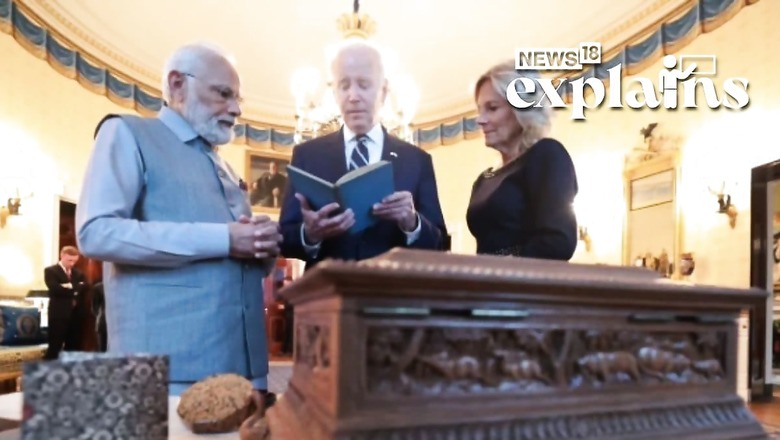
views
Prime Minister Narendra Modi on Wednesday thoughtfully presented US President Joe Biden with a rare first edition print of The Ten Principal Upanishads, recognising the leader’s profound admiration for Irish poet William Butler Yeats. This edition was published by Yeats in English in 1937 and co-authored by Purohit Swami.
President Biden frequently includes quotes from Yeats in his speeches, as the renowned Nobel laureate was not only deeply influenced by Indian spirituality but also held a profound admiration for India. Yeats’s close friendship and fondness for Bengali poet and writer Rabindranath Tagore were well-known, as he played a pivotal role in popularizing Tagore’s Gitanjali throughout the Western world, as per reports.
In reciprocation, the Bidens graciously presented several gifts to Prime Minister Modi, which included a meticulously crafted antique American book galley from the early 20th century, a vintage American camera, accompanied by an archival facsimile print of George Eastman’s Patent for the first Kodak camera, and a hardcover book showcasing American wildlife photography.
About the Ten Principal Upanishads
In 1937, Yeats published an English translation of the Indian Upanishads, co-authored with Purohit Swami. The translation and collaboration between the two authors occurred throughout the 1930s and it was one of the final works of Yeats.
“A copy of the first edition print of this book, The Ten Principal Upanishads’ published by M/s Faber and Faber Ltd of London and printed at the University Press Glasgow has been gifted to President Biden,” the government said in a press release.
What are the Upanishads?
The Upanishads hold significant importance as the philosophical-religious texts of Hinduism, also known as Sanatan Dharma, signifying the “Eternal Order” or “Eternal Path,” according to the World History Encyclopedia. They serve to explore the fundamental principles of the religion. The name itself can be interpreted as “sitting down closely,” reflecting the attentive listening one would give to instructions from a teacher or authoritative figure.
Simultaneously, Upanishad has also been understood as “secret teaching” or “revealing underlying truth.” These teachings delve into the concepts presented in the Vedas, the religious texts considered by orthodox Hindus as revealed knowledge about the creation and functioning of the universe, as per the report.
The term “veda” translates to “knowledge,” and the four Vedas are believed to embody the fundamental understanding of human existence. These works, regarded as Shruti in Hinduism, meaning “what is heard,” are believed to have originated from the vibrations of the universe and were initially transmitted orally by sages before being recorded in written form between approximately 1500 and 500 BCE. The Upanishads are considered the “end of the Vedas” (Vedanta) as they expand upon, elucidate, and develop the concepts found in the Vedas through narrative dialogues. In doing so, they encourage individuals to personally and spiritually engage with these concepts.
Who Was WB Yeats?
William Butler Yeats was born in Dublin, Ireland, into a family where his father was both a lawyer and a renowned portrait painter. He received his education in London and Dublin, but during the summers, he would reside in the family’s summer house in Connaught, located in the west of Ireland. During his youth, Yeats was deeply involved in the fin de siècle cultural milieu of London, according to nobelprize.com. He also actively participated in societies that aimed to revive Irish literature.
Although Yeats published his first volume of poetry in 1887, his early career was marked more by his prolific output of plays rather than poetry, both in terms of quantity and significance. Alongside Lady Gregory, he co-founded the Irish Theatre, which eventually evolved into the renowned Abbey Theatre. Yeats served as the principal playwright for the theatre until the arrival of John Synge. His plays primarily revolve around Irish legends and demonstrate his keen interest in mysticism and spiritualism.
Some of his well-known plays include “The Countess Cathleen” (1892), “The Land of Heart’s Desire” (1894), “Cathleen ni Houlihan” (1902), “The King’s Threshold” (1904), and “Deirdre” (1907). These works showcase Yeats’s profound engagement with Irish folklore and his exploration of mystical and spiritual themes.
How Did WB Get Into Hinduism?
William Butler Yeats, who considered himself “very religious,” explored various spiritual paths in his quest for Truth. One significant direction he turned to was Hinduism, according to author Janet Zimmerman Marsh in the Yeats Eliot Review, posted on Gale Academic Onefile.
Yeats’s initial encounter with Hindu philosophy occurred in 1885 or 1886 when he listened to Mohini Chatterjee speak. This encounter confirmed his vague speculations and provided him with a logical and boundless philosophy.
His interest in Hinduism grew even more intense when he met Purohit Swami in 1931, and it continued until the end of his life. Yeats expressed that he had been nourished by the Upanishads, a part of Hindu sacred scripture, throughout his entire life, Marsh said.
The Upanishads elucidate the inner spiritual journey by which the individual self (Atman) discovers the ultimate reality. Yeats’s fascination with the Upanishads is reflected in his poem “Meru” (1934). Thematically, “Meru” distinctly embraces Hindu concepts, and its formal structure mirrors the process of humanity’s ascent to Truth as taught in the Upanishads, thus enhancing the poem’s meaning.
Yeats wrote “Meru” after reading Purohit Swami’s work, “The Holy Mountain,” to which he also contributed an Introduction. In this introduction, Yeats narrates the spiritual odyssey of Purohit Swami and his master, Bhagwan Hamsa. Both embarked on arduous journeys, braving icy mountains to meditate and seek proof of the existence of the Absolute.
















Comments
0 comment